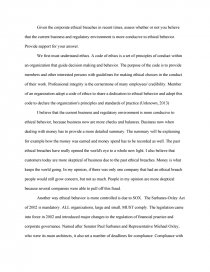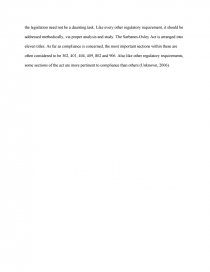Advertising and Communication Law
Essay by Angelnm01 • August 18, 2013 • Essay • 401 Words (2 Pages) • 1,496 Views
Given the corporate ethical breaches in recent times, assess whether or not you believe that the current business and regulatory environment is more conducive to ethical behavior. Provide support for your answer.
We first must understand ethics. A code of ethics is a set of principles of conduct within an organization that guide decision making and behavior. The purpose of the code is to provide members and other interested persons with guidelines for making ethical choices in the conduct of their work. Professional integrity is the cornerstone of many employees' credibility. Member of an organization adopt a code of ethics to share a dedication to ethical behavior and adopt this code to declare the organization's principles and standards of practice (Unknown, 2013)
I believe that the current business and regulatory environment is more conducive to ethical behavior, because business now are more checks and balances. Business now when dealing with money has to provide a more detailed summary. The summary will be explaining for example how the money was earned and money spend has to be recorded as well. The past ethical breaches have really opened the world's eye to a whole new light. I also believe that customers today are more skeptical of business due to the past ethical breaches. Money is what keeps the world going. In my opinion, if there was only one company that had an ethical breach people would still grow concern, but not as much. People in my opinion are more skeptical because several companies were able to pull off this fraud.
Another way ethical behavior is more controlled is due to SOX. The Sarbanes-Oxley Act of 2002 is mandatory. ALL organizations, large and small, MUST comply. The legislation came into force in 2002 and introduced major changes to the regulation of financial practice and corporate governance. Named after Senator Paul Sarbanes and Representative Michael Oxley, who were its main architects, it also set a number of deadlines for compliance. Compliance with the legislation need not be a daunting task. Like every other regulatory requirement, it should be addressed methodically, via proper analysis and study. The Sarbanes-Oxley Act is arranged into eleven titles. As far as compliance is concerned, the most important sections within these are often considered to be 302, 401, 404, 409, 802 and 906. Also like other regulatory requirements, some sections of the act are more pertinent to compliance
...
...

